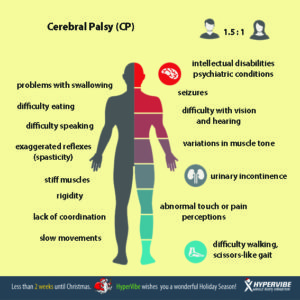THE SYMPTOMS YOU CAN COME ACROSS WITH CP: It all depends what area of the cerebral cortex has been damaged with what extent.
In some cases, the cerebral motor cortex hasn’t developed normally during fetal growth. In others, the damage is a result of injury to the brain either before, during, or after birth. In either case, the damage is not repairable and the disabilities that result are permanent.
Know the early signs and symptoms of Cerebral Palsy, if possible:
Some early warning signs:
In a Baby Younger Than 6 Months of Age
- His head lags when you pick him up while he’s lying on his back
- He feels stiff
- He feels floppy
- When you pick him up, his legs get stiff and they cross or scissor
In a Baby Older Than 6 Months of Age
- She doesn’t roll over in either direction
- She cannot bring her hands together
- She has difficulty bringing her hands to her mouth
- She reaches out with only one hand while keeping the other fisted
In a Baby Older Than 10 Months of Age
- He crawls in a lopsided manner, pushing off with one hand and leg while dragging the opposite hand and leg
- He cannot stand holding onto support
In some cases, the cerebral motor cortex hasn’t developed normally during fetal growth. In others, the damage is a result of injury to the brain either before, during, or after birth. In either case, the damage is not repairable and the disabilities that result are permanent.
Children with CP exhibit a wide variety of symptoms, including:
- lack of muscle coordination when performing voluntary movements (ataxia);
- stiff or tight muscles and exaggerated reflexes (spasticity);
- weakness in one or more arm or leg;
- walking on the toes, a crouched gait, or a “scissored” gait;
- variations in muscle tone, either too stiff or too floppy;
- excessive drooling or difficulties swallowing or speaking;
- shaking (tremor) or random involuntary movements;
- delays in reaching motor skill milestones; and
- difficulty with precise movements such as writing or buttoning a shirt.
The symptoms of CP differ in type and severity from one person to the next, and may even change in an individual over time. Symptoms may vary greatly among individuals, depending on which parts of the brain have been injured. All people with cerebral palsy have problems with movement and posture, and some also have some level of intellectual disability, seizures, and abnormal physical sensations or perceptions, as well as other medical disorders. People with CP also may have impaired vision or hearing, and language, and speech problems.
CP is the leading cause of childhood disabilities, but it doesn’t always cause profound disabilities. While one child with severe CP might be unable to walk and need extensive, lifelong care, another child with mild CP might be only slightly awkward and require no special assistance. The disorder isn’t progressive, meaning it doesn’t get worse over time. However, as the child gets older, certain symptoms may become more or less evident.
Remember, No two cases are the same! Varying degrees of injury to different parts of the brain mean that no two children with Cerebral Palsy are exactly alike. Some are so slightly affected that they have no obvious disability. Others may be severely disabled – to the extent that they have limited movement in both arms and legs, are unable to speak, feed themselves or control bladder and bowel movements. Such children will require lifelong care.
